curried tofu with spinach and tomatoes
 Last week when I was picking up some groceries, I threw a package of extra-firm tofu into the cart. When I got it home I put it in the freezer; a day or so later, I put the frozen package in the fridge to thaw out. I do this once in a while, because frozen pressed tofu has a great consistency for stir-frying. It’s a staple. Then last night, as I was getting my things ready for today, it occurred to me that I hadn’t made any plans for tonight’s dinner, that I had a thawing package of tofu in the fridge, and that I had at least two soy cookbooks still on the list for this blog. And after a few minutes of checking the indexes and skimming recipes, I had a plan: curried tofu with spinach and tomatoes, from The New Soy Cookbook.
Last week when I was picking up some groceries, I threw a package of extra-firm tofu into the cart. When I got it home I put it in the freezer; a day or so later, I put the frozen package in the fridge to thaw out. I do this once in a while, because frozen pressed tofu has a great consistency for stir-frying. It’s a staple. Then last night, as I was getting my things ready for today, it occurred to me that I hadn’t made any plans for tonight’s dinner, that I had a thawing package of tofu in the fridge, and that I had at least two soy cookbooks still on the list for this blog. And after a few minutes of checking the indexes and skimming recipes, I had a plan: curried tofu with spinach and tomatoes, from The New Soy Cookbook.
I seem to have three soy cookbooks. I don’t remember exactly when I got each, and frankly I’m kind of impressed I don’t have two copies of any of them. I also don’t remember which, if any, I have used before. There is some overlap among them, as well as with other more general vegetarian cookbooks (though as the menu of one of our favorite Japanese restaurants illustrates, just because a recipe contains soy doesn’t mean it’s vegetarian). I’ve made dishes like many of the ones in this book before, but I knew I hadn’t made this one because it calls for coconut.
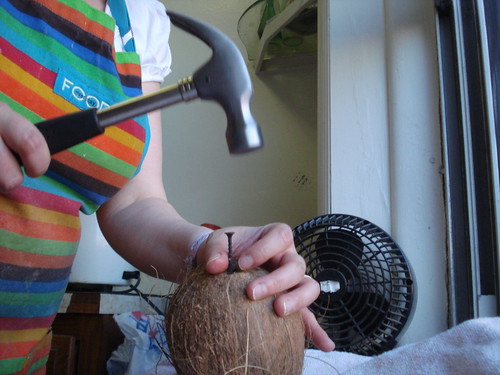 I grew up thinking I wasn’t a big fan of coconut. And of the kind that was most available when I was growing up in the Midwest — the chalky sweetened kind that you buy in the baking aisle and that turns over about as often as the starter on an Edsel — I am still not a fan. But fresh coconut, unsweetened coconut, has a good, honest flavor and is a great component of Asian dishes. Still, I had always been intimidated by the thought of puncturing and breaking open a fresh coconut, so I’d steered clear. But this time I thought, there’s no reason to be afraid. And besides, surely the produce stand has pre-packaged chunks of fresh, broken coconut.
I grew up thinking I wasn’t a big fan of coconut. And of the kind that was most available when I was growing up in the Midwest — the chalky sweetened kind that you buy in the baking aisle and that turns over about as often as the starter on an Edsel — I am still not a fan. But fresh coconut, unsweetened coconut, has a good, honest flavor and is a great component of Asian dishes. Still, I had always been intimidated by the thought of puncturing and breaking open a fresh coconut, so I’d steered clear. But this time I thought, there’s no reason to be afraid. And besides, surely the produce stand has pre-packaged chunks of fresh, broken coconut.
I was wrong. I’m sure it has in the past, but today, no. All I could find was whole fresh coconuts. So I picked one at random — it looks small, maybe it won’t be too hard to break — and headed home to try my luck. I remembered watching an episode of Good Eats in which Alton Brown easily opens a coconut, but the more I thought about it, the more convinced I was that he’d used a power drill to puncture the three little “eye” holes. That wasn’t going to be an option; we don’t have a power drill, or any kind of drill. I mentioned my misgivings to Scott.
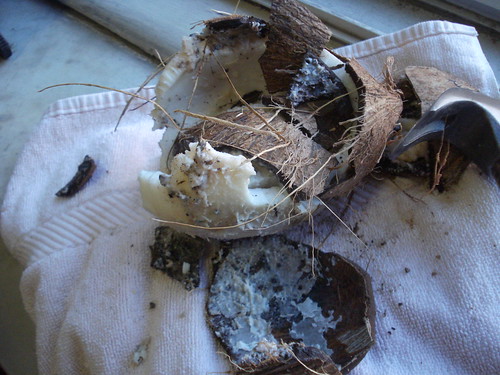 “People have been opening coconuts since long before there was electricity,” he responded. Then he used electricity in the form of power to his computer to do a quick Web search, and voila: HowToOpenACoconut.com. No power drills here! All I had to do, according to the site, was use a hammer and nail to puncture the three holes at one end so the liquid could drain out, then wrap the coconut securely in a towel and whack it with a hammer until it was as broken as I wished.
“People have been opening coconuts since long before there was electricity,” he responded. Then he used electricity in the form of power to his computer to do a quick Web search, and voila: HowToOpenACoconut.com. No power drills here! All I had to do, according to the site, was use a hammer and nail to puncture the three holes at one end so the liquid could drain out, then wrap the coconut securely in a towel and whack it with a hammer until it was as broken as I wished.
What could go wrong? I thought. My brain instantly conjured up images of smashed windows, shattered crockery, crushed thumbs, cracked marble windowsills, and cats who were in the wrong place at the wrong time. It occurred to me that loud thumping would scare away the cats, so that one didn’t worry me, and I forcefully pushed aside the other images, dug out a long nail (actually a pointed screw) from the junk box, and headed into the kitchen with hammer, screw and coconut in hand, with Scott close behind with a towel and the camera.
 Puncturing the three spots on the end was easy, and in mere minutes I had drained away the liquid and was ready to see if I could break the coconut with my own efforts. It gave pretty easily, which I quickly determined was because one end of it was actually a bit overripe. Still, the majority of the flesh was good, and it turned out to be quite simple to pare away what wasn’t quite right and still yield up a sufficient amount of hard, white coconut meat.
Puncturing the three spots on the end was easy, and in mere minutes I had drained away the liquid and was ready to see if I could break the coconut with my own efforts. It gave pretty easily, which I quickly determined was because one end of it was actually a bit overripe. Still, the majority of the flesh was good, and it turned out to be quite simple to pare away what wasn’t quite right and still yield up a sufficient amount of hard, white coconut meat.
 After cleaning up from that I was ready to start the regular vegetable prep: rinsing, stemming and chopping fresh spinach, seeding some plum tomatoes and cutting them into eighths, mincing some cilantro, chopping an onion. I prepped the tofu too: I squeezed the block between a cutting board and a flat dish, pressing several times until no more liquid came out; then I cut the block into cubes.
After cleaning up from that I was ready to start the regular vegetable prep: rinsing, stemming and chopping fresh spinach, seeding some plum tomatoes and cutting them into eighths, mincing some cilantro, chopping an onion. I prepped the tofu too: I squeezed the block between a cutting board and a flat dish, pressing several times until no more liquid came out; then I cut the block into cubes.
Scott got the rice cooker going and I staged my ingredients. Spinach, check; cilantro, check; onion, check; tomato, check; tofu, check. I looked at the recipe again to confirm how much grated coconut I needed and saw that the list actually specified unsweetened dried coconut. Well, hell. I closed my eyes and pictured the shelves at the grocery where the nuts and dried fruit could be found. Definitely no dried coconut. I shrugged, decided that fresh was a better substitute than chalky sweetened, and grated a little bit extra to make up for the fact that the flavor of the fresh coconut was probably less intense than dried would have been.
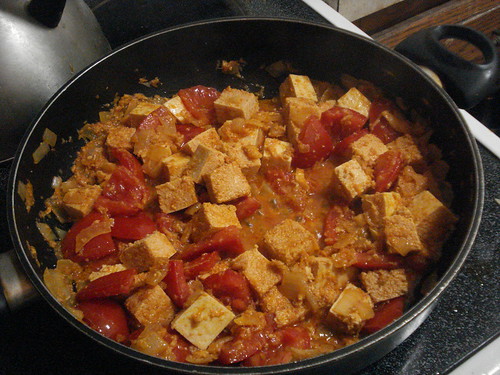 Next to stage was “mild curry paste.” Wait, what? The recipe’s explanatory note specified a brand, but that was irrelevant, almost provocative; one thing I’ve come to learn about grocery shopping in New York was that if a recipe specifies a particular processed food, the odds are against your being able to find exactly what you’re looking for. The shelves will have “lite” but not regular, or will have the 9-ounce but not the 11-ounce bottle, or will have only competing brands. I did have curry paste on my kitchen shelves already, as it turned out, a red Thai curry paste that is not especially mild. I sighed, considered that maybe the fresh coconut would balance it in some chimerical way, considered too the fact that we like hot food, and resolved that if the final cooked dish smelled too spicy when the lid came off we’d just spoon a bit less of it over extra rice.
Next to stage was “mild curry paste.” Wait, what? The recipe’s explanatory note specified a brand, but that was irrelevant, almost provocative; one thing I’ve come to learn about grocery shopping in New York was that if a recipe specifies a particular processed food, the odds are against your being able to find exactly what you’re looking for. The shelves will have “lite” but not regular, or will have the 9-ounce but not the 11-ounce bottle, or will have only competing brands. I did have curry paste on my kitchen shelves already, as it turned out, a red Thai curry paste that is not especially mild. I sighed, considered that maybe the fresh coconut would balance it in some chimerical way, considered too the fact that we like hot food, and resolved that if the final cooked dish smelled too spicy when the lid came off we’d just spoon a bit less of it over extra rice.
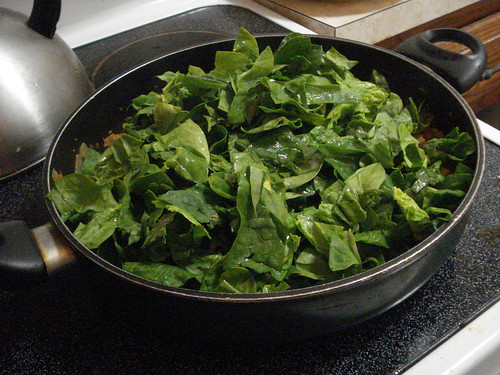 So after all this I was finally ready to cook, which turned out to be speedy and simple. I sauteed the chopped onion in some vegetable oil for about three minutes, then added the curry paste, some water, the coconut, the tofu and the tomatoes. I covered the pan and let it cook five minutes, then added the spinach, stirring it into the sauce and watching it wilt as I mixed. I covered the pan again and let it cook three more minutes, then pulled off the lid, stirred in the cilantro, and announced that dinner was ready.
So after all this I was finally ready to cook, which turned out to be speedy and simple. I sauteed the chopped onion in some vegetable oil for about three minutes, then added the curry paste, some water, the coconut, the tofu and the tomatoes. I covered the pan and let it cook five minutes, then added the spinach, stirring it into the sauce and watching it wilt as I mixed. I covered the pan again and let it cook three more minutes, then pulled off the lid, stirred in the cilantro, and announced that dinner was ready.
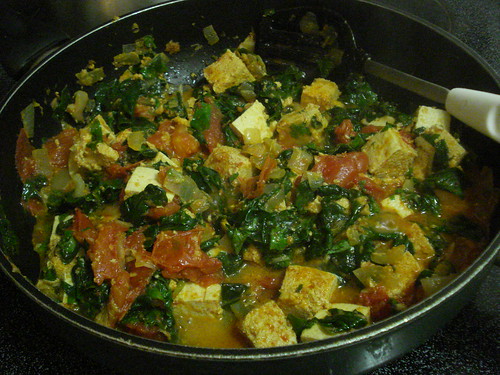 And after all my missteps and misgivings, it was great. The curry paste may have been hotter than intended but it gave a good, peppy, savory flavor. The coconut gave it some depth as well. The tofu cubes had soaked up lots of curry sauce and had a dense, spongy texture. The spinach actually distributed well, not clumping up as it can sometimes do in a sauce.
And after all my missteps and misgivings, it was great. The curry paste may have been hotter than intended but it gave a good, peppy, savory flavor. The coconut gave it some depth as well. The tofu cubes had soaked up lots of curry sauce and had a dense, spongy texture. The spinach actually distributed well, not clumping up as it can sometimes do in a sauce.
Verdict: Success. Now I’m kind of curious about how it would have tasted if I’d gotten it right.
The thing we loved best about getting fresh coconut when I was a kid was, after hammering the holes and draining the liquid, throwing the coconut as hard as we could off the back porch onto the concrete below until it broke. Play with your food indeed!
Another solution to too hot is dairy: a little yogurt or sour cream spooned on top, or raita or glass of milk alongside, or ice cream during dinner rather than for dessert…